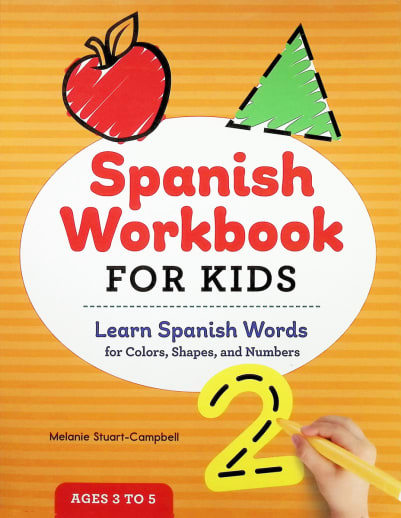I like this book for adding a printed element to your Spanish videos and songs. This helps them “see” what those words look like outside of the songs, etc. You could also use this as an introduction to your little learner, and add songs and videos to it. This approach would be something like Whistlefritz Spanish, for example. The author keeps it simple, focusing on colors, shapes and numbers. If you are not a Spanish speaker yourself, pronunciation help is right there to help you sound out the new words. You could also use a translation app or website to hear the words pronounced. Kids can color in the bold images and complete the puzzles. I like how the pages are not too cluttered and very appealing visually. ~Sara
Spanish Workbook for Kids
SKU
083877
ISBN
9781647390099
Grade PK
These icons are designed to help you quickly understand and learn important information about our products.
Teaching Method
Traditional
Teacher-centered curriculum commonly used in classrooms that may include a text, teacher manual, tests, etc.
Charlotte Mason
A methodology based on the work of a 19th century educator who maintained that children learn best from literature (Living Books), not textbooks.
Classical
A methodology based on the Latin Trivium (three stages of learning), including the grammar stage (memorization and facts), logic stage (critical thinking), and rhetoric stage (developing/defending ideas).
Unit Study
A thematic or topical approach centered around one topic that integrates multiple subject areas.
Montessori (Discovery)
A methodology based on the work of a 20th century educator that emphasizes student and sensory-driven discovery learning and real-life applications.
Other
Other methodologies
Religious Content
Secular
Contains content contrary to common Christian beliefs (i.e. evolution).
Neutral
Avoids religious or theoretical topics or presents multiple viewpoints without preference.
Christian/Religious
Faith-based or including instructional religious content.
Learning Modality
Auditory
Learns through listening, talking out loud or reading out loud.
Visual
Learns through seeing, prefers written instructions and visual materials.
Kinesthetic/Tactile (Hands-On)
Learns through moving, doing and touching.
Multi-Sensory
Curriculum that employ a variety of activities/components.
Presentation
Sequential
Curriculum progresses through well-defined learning objectives. Emphasizes mastery before moving to the next topic.
Spiral
Topics and concepts are repeated from level to level, adding more depth at each pass and connecting with review.
Conceptual/Topical
Focus is on the “why,” often with a unifying concept as well as specific skills; coverage may be broader.
Teacher Involvement
Low Teacher Involvement
Student-led materials; parent acts as a facilitator.
Medium Teacher Involvement
A mix of teacher-led time and independent student work.
High Teacher Involvement
Teacher-led lessons; may utilize discussions, hands-on activities and working together.
Additional Materials Required
No other materials needed
Everything you need is included.
Other Materials Required
There are additional required resources that are a separate purchase.
Other Materials Optional
There are additional resources mentioned or recommended but are not absolutely necessary.
Consumable
Consumable
Designed to be written in; not reusable.
Non-Consumable
Not designed to be written in; reusable.
Our Price
$9.99 $9.99 $8.50
Rainbow Savings: $1.49
Description
Publisher's Description of Spanish Workbook for Kids
Hola! Want to get children ages 3-6 excited about speaking a new language? Then the Spanish Workbook for Kids is the perfect choice! Filled with cute illustrations and super fun activities, the Spanish Workbook for Kids is ideal for keeping kids engaged as they learn. By focusing on 26 different words (10 colors, 5 shapes, and 11 numbers), the Spanish Workbook for Kids helps young learners familiarize themselves with these basic terms, as well as practice recognizing them in a variety of ways?including using them together! Now, vamanos!
The Spanish Workbook for Kids includes:
Details
| Product Format: | Paperback |
|---|---|
| Grade: | PK |
| Brand: | Rockridge Press |
| ISBN: | 9781647390099 |
| Length in Inches: | 11 |
| Width in Inches: | 8.5 |
| Height in Inches: | 0.25 |
| Weight in Pounds: | 0.65 |
Videos
Reviews

